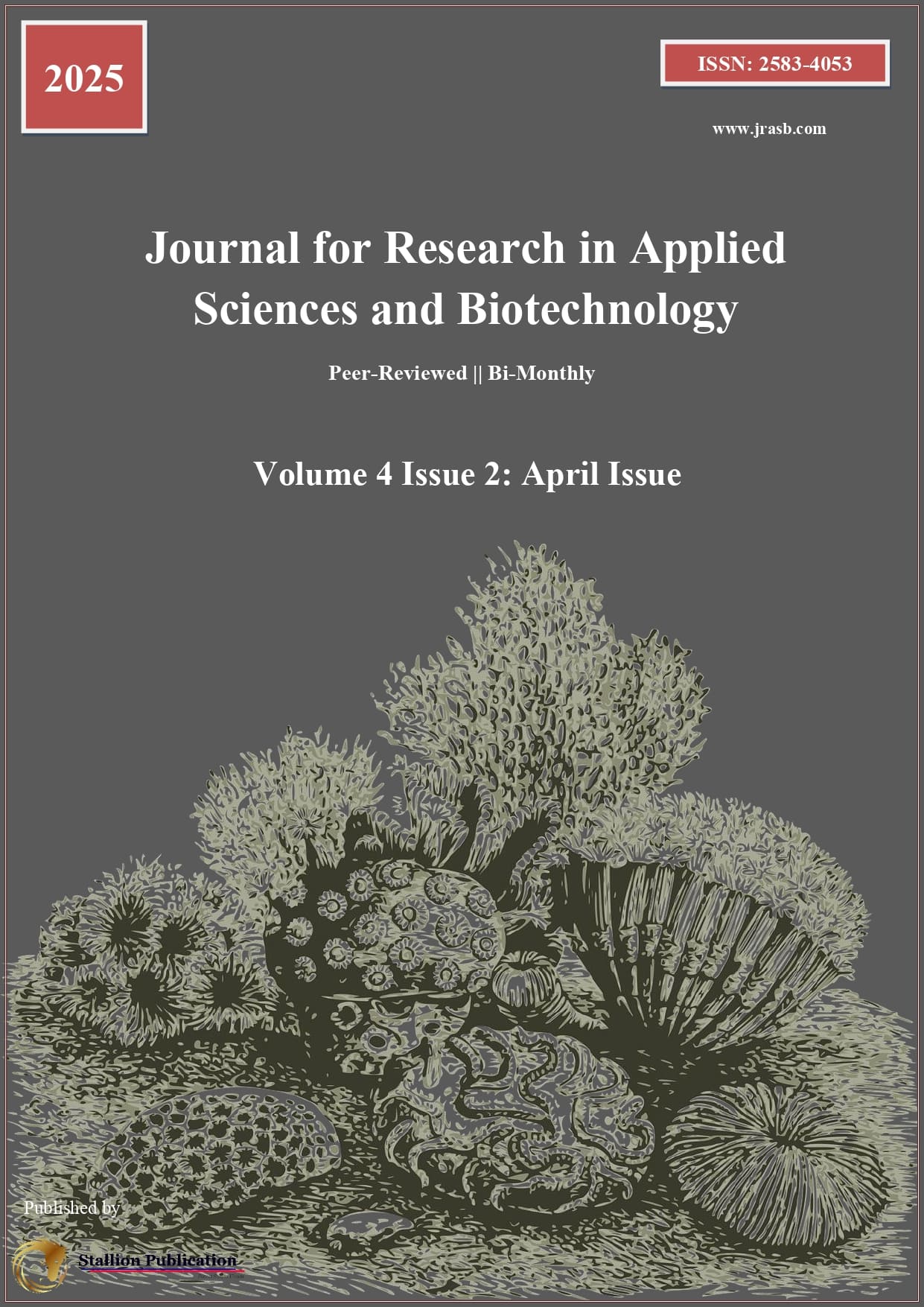Ethnopharmacological, Phytochemical and Pharmacological Uses of Genus Morchella: A Systematic Review
DOI:
https://doi.org/10.55544/jrasb.4.2.6Keywords:
Morchella, ethnopharmacology, phytochemicals, pharmacological activities, medicinal mushrooms, bioactive compoundsAbstract
Morel is an edible fungus belonging to the genus Morchella that is highly prized for value-added foods due to its unique flavor and planar nutrition profile. Aside from their culinary importance, morels have gained much attention in regard with their ethnopharmacological and pharmacological properties. Different species of this genus have been used in folk medicine in various cultures, mostly in Asia, Europe, and North America. Potential therapeutics from Morchella spp. over their broad spectrum of bioactive compounds, such as polysaccharides, sterols, fatty acids, alkaloids, and phenolic compounds. These constituents demonstrate a diverse spectrum of biological actions including antioxidant, anti-inflammatory, antimicrobial, immunomodulatory, and anticancer activities. There are ethnopharmacological studies showing that Morchella spp. shown to help with fatigue, respiratory problems, and gastrointestinal disorders. In traditional Chinese medicine, they are commonly used to boost health and immune health. Modern pharmacological research has confirmed some of these uses, as in vitro and in vivo studies have shown considerable health benefits. Morchella polysaccharides exhibit immunomodulatory activity and extracts exhibit antimicrobial activity against a variety of pathogenic organisms. Furthermore, Morchella-derived compounds showed potential anticancer effects via apoptosis and cell cycle arrest in cancer. Morchella spp have been shown through phytochemical analyses to contain are important sources of essential amino acids, vitamins, and minerals, which is why it has nutritional and medicinal values. Their antioxidative potential is also rooted in the unique profile of sterols and phenolic compounds. Over the past few years, researchers have isolated and characterized these bioactive molecules to identify their mechanisms of action and potential therapeutic applications. Although the medicinal properties of morels have been documented in the literature, further clinical studies are required to establish both their clinical efficacy and safety in human cohorts.
Downloads
References
Anand K, Mandal D, Parbhakar PK. Phytochemical Profiling, In-Vitro Antioxidant, and Antidiabetic Evaluation of Morchella esculenta: A Comprehensive Investigation. Lett Appl NanoBioScience. 2024;14(1):43.
Yasin NA, Zahoor M, Naz S, Haq IU. Ethnopharmacological exploration of medicinal mushroom from four provinces of Pakistan. J Ethnopharmacol. 2018;214:86–102.
Mahtal A, Lamchouri F, Toufik H. Morchella esculenta (L.) Pers. Wild of the Province of Taza, Morocco: Ethnomedicinal and Socio-Economic Survey and Perspectives. Trop J Nat Prod Res. 2024;8(11):9019–26.
Sharma Y, Singh B. Morchella esculenta Dill. ex Pers., an important medicinal mushroom of Himalaya: traditional usages, phytochemistry, pharmacology and need for scientific intervention. In: Singh B, editor. Plants of Commercial Values. New Delhi: New India Publishing Agency; 2019. p. 1–16.
Kumar S, Sharma S. Morchella esculenta: A herbal boon to pharmacology. Int J Pharm Pharm Sci. 2018;10(7):1–4.
Anand K, Mandal D. Phytochemical profiling and in-vitro evaluation of Morchella esculenta. AIP Conf Proc. 2023;2986(1):030155.
Amin T, Thakur M. Medicinal and indigenous use of Morchella esculenta for socio-economic development: A review. Asian J Environ Sci. 2021;16(1):51–7.
Zhang J, Wang G, Li C, Wang Z. Bioactivity-guided isolation and chemical characterization of cytotoxic compounds from Morchella esculenta. Phytomedicine. 2018;46:97–102.
Ma X, Zheng Y, Fan D. A review of the ethnopharmacology, phytochemistry, pharmacology, and toxicology of Paeonia lactiflora Pall. J Ethnopharmacol. 2023;310:116628.
Li W, Zhou P, Zhang Y. A review on ethnopharmacology, phytochemistry, pharmacology, and toxicology of Portulaca oleracea L. J Ethnopharmacol. 2023;310:116628.
Kües U, Liu Y. Fruiting body production in basidiomycetes. Appl Microbiol Biotechnol. 2000;54(2):141–52.
Ooi VE, Liu F. A review of pharmacological activities of mushroom polysaccharides. Int J Med Mushrooms. 1999;1(3):195–206.
Wasser SP. Medicinal mushrooms as a source of antitumor and immunomodulating polysaccharides. Appl Microbiol Biotechnol. 2002;60(3):258–74.
Gao Y, Zhou S, Huang M. Effects of Ganoderma lucidum polysaccharides on immune function in cancer patients: a randomized double-blind placebo-controlled study. J Clin Oncol. 2003;21(22):4529–35.
Zhang M, Cui SW, Cheung PC, Wang Q. Antitumor polysaccharides from mushrooms: a review on their isolation process, structural characteristics and antitumor activity. Trends Food Sci Technol. 2007;18(1):4–19.
Lindequist U, Niedermeyer TH, Jülich WD. The pharmacological potential of mushrooms. Evid Based Complement Alternat Med. 2005;2(3):285–99.
Patel S, Goyal A. Recent developments in mushrooms as anti-cancer therapeutics: a review. 3 Biotech. 2012;2(1):1–15.
Zhao C, Sun H, Tong X, Qi Y. An overview of mushroom research in China: edible mushrooms, polysaccharides, and ergosterol. Biotechnol Adv. 2013;31(5):721–31.
Wang H, Ng TB. A ribonuclease from the wild mushroom Agaricus bisporus. Biochem Biophys Res Commun. 2000;269(2):557–61.
Ng TB. A review of research on the protein-bound polysaccharide (polysaccharopeptide, PSP) from the mushroom Trametes versicolor (formerly Coriolus versicolor). Gen Pharmacol. 1998;30(1):1–4.
Zaidman BZ, Yassin M, Mahajna J, Wasser SP. Medicinal mushroom modulators of molecular targets as cancer therapeutics. Appl Microbiol Biotechnol. 2005;67(4):453–68.
Zhao J, Li SP, Yang FQ, Li P, Wang YT. Simultaneous determination of nucleosides and bases in Ganoderma by high-performance liquid chromatography. J Chromatogr A. 2006;1112(1–2):140–4.
Zhang Y, Li S, Wang X, Wang H, Liang Z, Zhang Y. Optimization of fermentation conditions for exopolysaccharide production by Morchella esculenta SO-02. Carbohydr Polym. 2012;87(1):84–90.
Downloads
Published
How to Cite
Issue
Section
License
Copyright (c) 2025 Devinder Kumar, Sarvagya Suman, Anand Kumar Jha, Taranpreet Singh, Gurdeep Singh

This work is licensed under a Creative Commons Attribution-NonCommercial-NoDerivatives 4.0 International License.


















